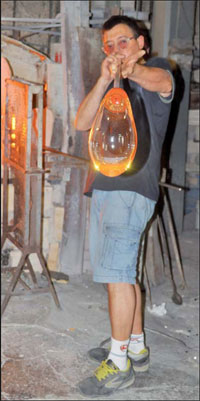Chasing the glittering prize
Updated: 2012-08-03 11:09
By Lu Chang (China Daily)
|
|||||||||||
|
Laura Fincato is president of Committee Expo Venice and vice-mayor of Venice. [Photo Provided to China Daily] |
Will Chinese take a shine to venetian glassware and hold a shattered industry together?
With its centuries-old industry on the point of ruin, Murano island in the Venetian lagoon is eager to send its intricate handmade glassware to a big, whole new market.
Laura Fincato, president of Committee Expo Venice and vice-mayor of Venice, told China Daily during a Murano glass exhibition in Beijing recently that she was looking forward to embracing the Chinese market.
"Murano glass is really a piece of art with a craft that has been passed down through generations," she says.
"Though the Chinese market is still new to us, I think it is only a matter of time before its customers appreciate the uniqueness and value of the glass pieces."
The nearest island to Venice has been a center for glassmaking since the late 13th century.
Today craftsmen continue to shape the glass by hand, working with the same tools that were used 700 years ago.
Prized for its rich colors and original design, Venetian glass used to draw throngs of tourists to the city, lining up to buy Murano creations, many priced at thousands of euros.
But the glory days are long gone. Orders are now on hold, layoffs are rising and glass factories are being forced to shut or are being turned into hotels.
Demand has crumbled over the past two years, and tourists are staying away, with the debt crisis in Italy, Europe's fourth largest economy, making matters worse for local industry.
According to Gianni de Checchi, secretary of the Confartigianato di Venezia, a trade group of artisans, the annual revenue from artistic glass sales has dropped from an estimated 200 million euros in 2002 to about 150 million euros last year.
|
|
|
Murano glassware is famous for traditional craftsmanship by which glass is shaped by hand. [Photo Provided to China Daily] |
Earlier reports said about a third of Murano's glassmakers have shut down or cut working hours. The workforce has shrunk from about 6,000 in 1970 to 900 now.
As a result, Murano glass makers have been forced to look to new markets such as China, where their brands are less known but where consumers have grown an appetite for luxury Italian products such as Prada, Gucci and Fendi.
The Italian Mall, with an investment of 20 million yuan ($3.14 million, 2.55 million euros), is set to open soon at Sanlitun, a busy commercial district in Beijing, home to many upmarket Western brands and stores.
After several years of dealing with made-in-Italy manufacturers, Zhang Chenghui, president of Italian Mall, plans to import Murano glass products, such as miniature animal families, vases, and delicate rococo chandeliers, to China from local factories.
"The beauty of these glass pieces lies in the amazing craft skills," she says.
"Once I spotted them in Venice during a trip to Italy, I couldn't pull my eyes away. That's when I decided to bring them back to China."
But beauty has its price. Genuine Murano glass products sell from several hundred to several million yuan.
"It's precious because you can never find two pieces the same," Zhang says.
"Once you know that it sometimes takes a master hundreds of hours to finish one piece, you can understand that the price is reasonable.
"Besides, some of them are made by world-famous glass masters such as Pino Signoretto, Signoretto Silvano and Davide Salvadore, adding more value."
Apart from Murano glassware, handmade furniture, paintings, and jewelry, all made in Italy, will be available at the 1,085-square meter Italian Mall, due to open at the end of this year.
Whether the Chinese will value artistic glassware as much as they do other luxury goods is still unknown, but Zhang says that 79 Murano pieces were sold at a recent three-day exhibition of more than 300, reflecting a growing appreciation of Chinese for the works of art.
"Like colored glaze or liuli, a type of multi-hued crystal glass dating back to China's Tang Dynasty (AD 618-907), where it took a long time for Chinese buyers to realize its true value, Murano glass will soon be the next objects of desire in the Chinese market," she says.
But not everyone has been impressed by the delicate craftsmanship.
"It is just glass whether it is one of a kind or can be found in many other places," says Ye Ke, a visitor to the show.
But Zhang has no worries about selling her products. After all, the increasing number of wealthy Chinese individuals is still the driving force behind many European luxury brands' rush into China.
A new report from CLSA, a Hong Kong-based brokerage, says that more than half of this year's growth in sales of luxury goods will come from China, where they are set to soar by 24 percent.
The country is already the largest market for jewelry after the United States, and for gold after India, and is gaining fast on both.
"With 300 million middle-class consumers, the Chinese market means a sea of opportunities for Italian companies, as the growth of China and the growing consumer strength here helps to drag the Italian economy out of recession," says Antonino Laspina, head of the Italian Trade Commission in China, an Italian government agency promoting business between Italy and China.
lvchang@chinadaily.com.cn
(China Daily 08/03/2012 page20)
Today's Top News
Rescuers race against time for quake victims
Telecom workers restore links
Coal mine blast kills 18 in Jilin
Intl scholarship puts China on the map
More bird flu patients discharged
Gold loses sheen, but still a safe bet
US 'turns blind eye to human rights'
Telecom workers restore links
Hot Topics
Lunar probe , China growth forecasts, Emission rules get tougher, China seen through 'colored lens', International board,
Editor's Picks

|

|

|

|

|

|







